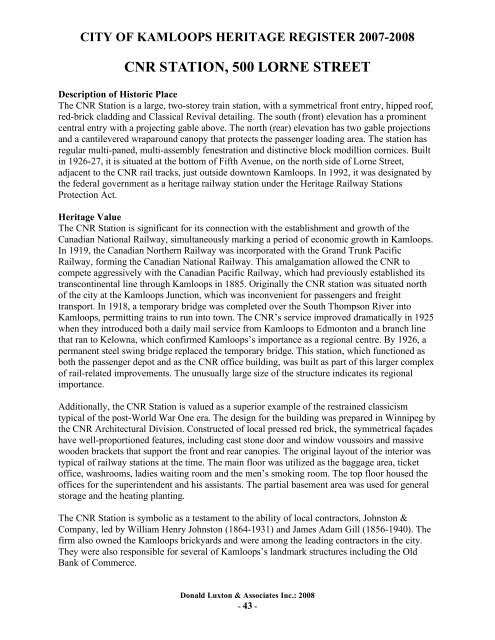Kamloops Heritage Register - City of Kamloops
Kamloops Heritage Register - City of Kamloops
Kamloops Heritage Register - City of Kamloops
Create successful ePaper yourself
Turn your PDF publications into a flip-book with our unique Google optimized e-Paper software.
CITY OF KAMLOOPS HERITAGE REGISTER 2007-2008<br />
CNR STATION, 500 LORNE STREET<br />
Description <strong>of</strong> Historic Place<br />
The CNR Station is a large, two-storey train station, with a symmetrical front entry, hipped ro<strong>of</strong>,<br />
red-brick cladding and Classical Revival detailing. The south (front) elevation has a prominent<br />
central entry with a projecting gable above. The north (rear) elevation has two gable projections<br />
and a cantilevered wraparound canopy that protects the passenger loading area. The station has<br />
regular multi-paned, multi-assembly fenestration and distinctive block modillion cornices. Built<br />
in 1926-27, it is situated at the bottom <strong>of</strong> Fifth Avenue, on the north side <strong>of</strong> Lorne Street,<br />
adjacent to the CNR rail tracks, just outside downtown <strong>Kamloops</strong>. In 1992, it was designated by<br />
the federal government as a heritage railway station under the <strong>Heritage</strong> Railway Stations<br />
Protection Act.<br />
<strong>Heritage</strong> Value<br />
The CNR Station is significant for its connection with the establishment and growth <strong>of</strong> the<br />
Canadian National Railway, simultaneously marking a period <strong>of</strong> economic growth in <strong>Kamloops</strong>.<br />
In 1919, the Canadian Northern Railway was incorporated with the Grand Trunk Pacific<br />
Railway, forming the Canadian National Railway. This amalgamation allowed the CNR to<br />
compete aggressively with the Canadian Pacific Railway, which had previously established its<br />
transcontinental line through <strong>Kamloops</strong> in 1885. Originally the CNR station was situated north<br />
<strong>of</strong> the city at the <strong>Kamloops</strong> Junction, which was inconvenient for passengers and freight<br />
transport. In 1918, a temporary bridge was completed over the South Thompson River into<br />
<strong>Kamloops</strong>, permitting trains to run into town. The CNR’s service improved dramatically in 1925<br />
when they introduced both a daily mail service from <strong>Kamloops</strong> to Edmonton and a branch line<br />
that ran to Kelowna, which confirmed <strong>Kamloops</strong>’s importance as a regional centre. By 1926, a<br />
permanent steel swing bridge replaced the temporary bridge. This station, which functioned as<br />
both the passenger depot and as the CNR <strong>of</strong>fice building, was built as part <strong>of</strong> this larger complex<br />
<strong>of</strong> rail-related improvements. The unusually large size <strong>of</strong> the structure indicates its regional<br />
importance.<br />
Additionally, the CNR Station is valued as a superior example <strong>of</strong> the restrained classicism<br />
typical <strong>of</strong> the post-World War One era. The design for the building was prepared in Winnipeg by<br />
the CNR Architectural Division. Constructed <strong>of</strong> local pressed red brick, the symmetrical façades<br />
have well-proportioned features, including cast stone door and window voussoirs and massive<br />
wooden brackets that support the front and rear canopies. The original layout <strong>of</strong> the interior was<br />
typical <strong>of</strong> railway stations at the time. The main floor was utilized as the baggage area, ticket<br />
<strong>of</strong>fice, washrooms, ladies waiting room and the men’s smoking room. The top floor housed the<br />
<strong>of</strong>fices for the superintendent and his assistants. The partial basement area was used for general<br />
storage and the heating planting.<br />
The CNR Station is symbolic as a testament to the ability <strong>of</strong> local contractors, Johnston &<br />
Company, led by William Henry Johnston (1864-1931) and James Adam Gill (1856-1940). The<br />
firm also owned the <strong>Kamloops</strong> brickyards and were among the leading contractors in the city.<br />
They were also responsible for several <strong>of</strong> <strong>Kamloops</strong>’s landmark structures including the Old<br />
Bank <strong>of</strong> Commerce.<br />
Donald Luxton & Associates Inc.: 2008<br />
- 43 -

















